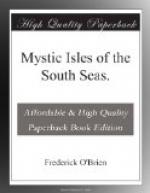At Fa’a a postwoman appeared. Before opening the mail-box she tarried to light a cigarette and to chat with the driver about the new picture at the cinema in Papeete. She commented laughingly on the writers and addressees of the letters, and flirted with a passenger. The former himene-house, which had been the dance-hall of Kelly, the leader of the fish-strike, was vacant, but I heard in imagination the strains of his pagan accordion, and the himene which will never be forgotten by the Tahitians, “Hallelujah! I’m a bum!” Kelly had gone over the water to the jails of the United States, where life is hard for minstrels who sing such droll songs.
In Punaauia, the next district to Fa’a, was a schoolhouse and on it a sign: 2 x 2 = 4.
M. Souvy, a government printer of Tahiti, had given the site out of his humble savings. By the sign, in his blunt way, he struck at education which does not teach the simple necessity of progress—common sense.
“Cela saute aux yeux,” he had said.
He was long dead, but his symbol provoked a question from every new-comer, and kept alive his name and philosophy. I never saw it but I thought of an article I had once written that led to the overturning of the educational system of a country. How all guide-posts point to oneself! Near the school-house, a dozen yards from the salt water, was a native house with a straw roof, a mere old shell, untenanted.
M. Edmond Brault, the government employee and musical composer, a passenger on the diligence, had with him his violin, intending to spend the day in company with it in a grove. He remarked the tumbledown condition of the house, and said:
“I have sat under that toil de chaume, that straw roof, and talked with and played for a painter who was living there quite apart from the world. He was Monsieur Paul Gauguin, and he had a very distingue establishment. The walls of his atelier were covered with his canvases, and in front of the house he had a number of sculptures in wood. That was about 1895, I think. I can see the maitre now. He wore a pareu of red muslin and an undershirt of netting. He said that he adored this corner of the world and would never leave it. He had returned from Paris more than ever convinced that he was not fitted to live in Europe. Yet, mon ami, he ran away from here, and went to the savage Marquesas Islands, where he died in a few years. He loved the third etude of Chopin, and the andante of Beethoven’s twenty-third sonata. You know music says things we would be almost afraid to put in words, if we could. If Flaubert might have written ‘Madame Bovary’ or ‘Salambo’ in musical notes, he would not have been prosecuted by the censor. We musicians have that advantage.”
“In America,” I replied, “we have never yet censored musical compositions, and many works are played freely because the censors and the reform societies’ detectives cannot understand them. But if our inquisitors take up music, they may yet reach them. For instance, the prelude of ‘Tristan and Isolde,’ and Strauss’ ‘Salome.’”




